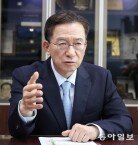Let`s Learn from the Soccer Leagues of Developed Countries
Let`s Learn from the Soccer Leagues of Developed Countries
Posted August. 12, 2005 03:04,
Nowadays, the Korean professional soccer world is closely observing Bucehon SKs self-reliance procurement project.
Bucheon General Manager Chung Soon-ki said, We are considering various methods to get financial self-reliance. We will be a new club that is highly efficient with our invested money and that gives pleasure to our fans. It is expected for other clubs to follow suit and get rid of the image of money eating hippos and run their own self-reliance programs.
It is Time to Scout Management Experts to Earn Profits
The general manager of Incheon United, a club run by the city of Incheon, Ahn Jong-bok guarantees, It is very possible for domestic professional soccer teams to have their check balances in the black.
In first half this season, Incheon earned 4.6 billion won by receiving a two billion won sponsorship from GM Daewoo, one billion won from POSCO E&C, and 1.6 billion won for trading Choi Tae-wook to the Shimizu S-Pulse, a Japanese team. If they trade Radonchichi, from Serbia Montenegro, to a Japanese team willing to pay $1.5 million, they will at least earn eight billion won, the teams minimum annual budget.
Nevertheless, in order to earn profits, a management expert is needed. In reality, there are virtually no experts with the ability raise the quality of a product called soccer and earn profits with adequate marketing.
Bubble in Price of Players Should be Burst and Long Term Visions Should be Set
The Japanese professional soccer league, or J-League, debuted in 1993, and showed astonishing growth during five to six years. However, with the long economic slump, it fell into a crisis in the late 1990s. The J-League executive office came up with the long-term slogan, Lets make Japan a happier country through sports and battled to adopt new management principles such as transparency in management, developing soccer management experts, establishing a management advisory committee, and diversifying ownership of clubs. The J-League office persistently persuaded clubs and provincial governments, and succeeded, in turning most teams, with the exclusion of a few, into profitable businesses.
In order to eliminate bubbles in the price of players, the J-League and the clubs joined hands.
They divided the players into categories A, B, and C, and set a salary cap for each category. That was benchmarking Germanys Bundesliga, where each club divides player categories into 10 categories, and uses it as the criteria for salaries. Japanese players eagerly joined in to save a dying J-League.
The biggest reason that the J-League, created in 1993, has an exemplary management system on par with professional European soccer leagues that have a history beyond a century is because they set up a long-term vision and collaborate to succeed.
Seoul National University Sports Management Professor Kang Joon-ho said that the domestic professional soccer world does not recognize how great of a crisis they are in right now. They should not only strive for a good record, but have a sense of community that they are all in the same boat, and try to find a solution as soon as possible.
Jong-Koo Yang Jae-Yun Jung yjongk@donga.com jaeyuna@donga.com







